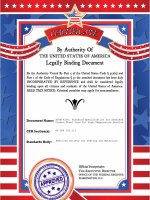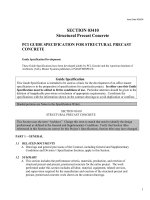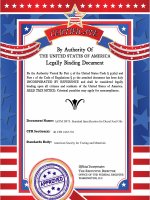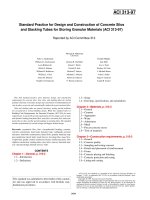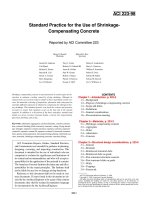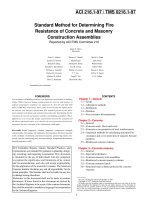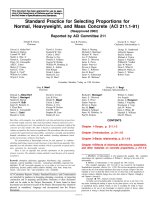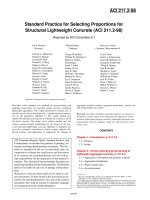standard specification for curing concrete
Bạn đang xem bản rút gọn của tài liệu. Xem và tải ngay bản đầy đủ của tài liệu tại đây (163.64 KB, 9 trang )
ACI 308.1-98 became effective April 1, 1998.
Copyright 1998, American Concrete Institute.
All rights reserved including rights of reproduction and use in any form or by any
means, including the making of copies by any photo process, or by electronic or
mechanical device, printed, written, or oral, or recording for sound or visual reproduc-
tion or for use in any knowledge or retrieval system or device, unless permission in
writing is obtained from the copyright proprietors.
308.1-1
Summary:
This specification provides requirements for alternative methods
for curing concrete. These alternative methods are not necessarily equal in
effectiveness, cost, effect on project schedule, or impact on other aspects of
the project. To use this specification, the Architect/Engineer must not only
include this document by reference in the project specifications, but must
also identify the concrete elements that are to be cured, and must choose
the method to be used to cure those elements. This specification has
installed default settings that may or may not be applicable to a specific
project. The Architect/Engineer is to use the Checklists included in this
specification to customize the specification to a specific project. Checklists
are provided in this document to guide the Architect/Engineer through
these selection processes, and the selections must be included in the project
specification. Alternatively, the Architect/Engineer may allow the contrac-
tor the option of using one or more of a number of permissible curing meth-
ods, subject to review and approval. Further, the Architect/Engineer must
determine whether deliberate curing efforts must or may terminate after a
predetermined time has elapsed, or only after specified concrete proper-
ties have developed. When deliberate efforts to cure the concrete are to be
ter
minated only when specified concrete properties have developed, the
Architect/Engineer must also select the test method used to measure those
properties.
Keywords:
cold-weather construction; concrete; concrete construction;
curing; curing films and sheets; hot weather construction; insulating con-
crete; insulation; membrane-curing compounds; moist curing; moisture
retention; sealers; water curing.
FOREWORD
F1.
This foreword is included for explanatory purposes
only; it is not a part of Standard Specification ACI 308.1.
F2.
Standard Specification ACI 308.1 is a Reference Stan-
dard which the Architect/Engineer may cite in the Project
Specifications for any building project, together with supple-
mentary requirements for the specific project.
F3.
Each technical section of Standard Specification ACI
308.1 is written in the Three-Part Section Format of the Con-
struction Specifications Institute, as adapted by ACI and
modified to ACI requirements. The language is generally
imperative and terse.
F4.
Checklists do not form a part of Standard Specification
ACI 308.1. Checklists are to assist the Architect/Engineer in
properly choosing and specifying the necessary mandatory
requirements for the Project Specifications.
PREFACE TO SPECIFICATIONS CHECKLIST
P1.
Standard Specification ACI 308.1 is intended to be
used by reference or incorporation in its entirety in the
Project Specifications. Individual sections, articles, or para-
graphs shall not be copied into the Project Specifications,
since taking them out of context may change their meaning.
Standard Specification
for Curing Concrete (ACI 308.1-98)
ACI 308.1-98
Reported by ACI Committee 308
Kenneth C. Hover—Chairman
*
Don Brogna* Samuel B. Helms Bryant Mather
*
Joseph Cabrera Edward Peter Holub
*
David McDonald*
James N. Cornell, II
*
Doug Hooton H. Celik Ozyildirim
Ronald L. Dilly Cecil L. Jones William S. Phelan
*
Jerome H. Ford Frank A. Kozeliski Luke M. Snell
Steven H. Gebler
*
Richard W. Kriner
*
Joel Tucker
Gilbert J. Haddad James A. Lee
*
John B. Wojakowski
With assistance from Aimee Pergalsky and Bob Truitt
*
Members of Subcommittee contributing to this document.
308.1-2
MANUAL OF CONCRETE PRACTICE
The specification is written to allow each method of curing
to be a stand-alone specification. The specifier is to deter-
mine the desired results of the curing and select the appropri-
ate section or sections to achieve those results. Section 1
shall be included with the selected sections. The specifier is
to use ACI 308-92 Standard Practice for Curing Concrete as
commentary for making decisions within the checklists. The
alternative methods described in each section of this Stan-
dard Specification are not necessarily equal in effectiveness,
cost, effect on project schedule, or impact on other aspects of
the project. To use this specification, the Architect/Engineer
must not only include this document by reference in the
Project Specifications, but must also review and respond to
the checklists. It is imperative that the Architect/Engineer
customize this specification to meet the project requirements
through the checklists. The Architect/Engineer must identify
the concrete elements that are to be cured, and must choose
the method to be used to cure them. Further, the Architect/
Engineer must determine whether deliberate curing efforts
must or may terminate after a predetermined time has
elapsed, or only after particular levels of concrete properties
have developed. When deliberate efforts to cure the concrete
are to be terminated only when particular concrete properties
have developed, the Architect/Engineer must also select the
test method used to measure those properties. Checklists are
provided in this document to guide the Architect/Engineer
through these selection processes, and the selections must be
included in the Project Specifications.
Section/Part/Article of
ACI 308.1-98 Notes to the Architect/Engineer
1.4
The Architect/Engineer shall review the referenced standards to ensure the
published dates are applicable to the specific project.
1.1.1 and 1.1.2
Describe the work that is to be cured as required by this specification, or alter-
nately, describe that work that is not to be cured in accordance with this spec-
ification. Specify the elements for which this specification does not apply.
1.1.3
Deliberate curing efforts may be terminated when either a predetermined time
period has elapsed, or when specific levels of concrete properties have devel-
oped in the concrete in the field or in representative samples in the laboratory.
The Architect/Engineer determines which of these criteria are to be employed
in Paragraphs 1.1.7.1, 1.1.7.2, and 1.1.7.3.
1.1.5.1
Unless the Architect/Engineer requires otherwise in the project specifications,
Section 1.1.6.1 will permit the use of any of the curing methods described in
Sections 2 through 7 for unformed surfaces.
1.1.5.2
Unless the Architect/Engineer requires otherwise in the project specifications,
Section 1.1.6.2 requires that for formed surfaces, absorbent forms be kept wet
until removal, followed by the application of any of the curing methods de-
scribed in Sections 2 through 7 until duration or strength requirements are met.
1.1.5.1, 1.1.5.2, and Section 5
Fogging, as described in Section 5, may be specified. There may be insuffi-
cient bleed water to maintain proper moisture conditions, or where little mois-
ture loss can be tolerated. Concrete containing finely ground cements,
expansive cement, fly ash, ground granulated blast furnace slag, silica fume,
or other cementitious materials, or having a water-cementitious materials ratio
less than 0.40 by mass, may require fogging during the initial curing period.
Fogging can help to prevent plastic shrinkage cracking.
M. MANDATORY SPECIFICATION CHECKLIST
P2. If sections or parts of Standard Specification ACI
308.1 are edited into project specifications or any other doc-
ument, they shall not be referred to as ACI standards, since
the Standard Specification has been altered.
P3. Building codes set minimum requirements necessary
to protect the public. This Standard Specification may stipu-
late requirements more restrictive than the minimum. Ad-
justments to the needs of a particular project shall be made
by the Architect/Engineer by reviewing each of the items in
the Specification Checklist and then including the Architect/
Engineer’s decision on each item as a mandatory require-
ment in the Project Specifications.
P4. These mandatory requirements designate the specific
qualities, procedures, materials, and performance criteria for
which alternatives are permitted or for which provisions
were not made in the Standard Specification. Exceptions to
the Standard Specification shall be made in the Project Spec-
ifications, if required.
P5. A statement such as the following will serve to make
Standard Specification ACI 308.1 a part of the Project Spec-
ifications:
Work on (Project Title)
shall conform to all require-
ments of ACI (Standard Specification number with
date suffix and title)
published by the American Con-
crete Institute, Farmington Hills, Michigan, except as
modified by the requirements of these Contract Docu-
ments.
P6. The Standard Specification Checklists identify Archi-
tect/Engineer choices and alternatives. The checklists identify
the sections, parts, and articles of the Standard Specification
and the action required by the Architect/Engineer.
308.1-3
CURING CONCRETE
1.1.6
The Architect/Engineer is to select the curing period (Paragraph 1.1.3) and the
method to be used to determine when deliberate curing measures can be termi-
nated (Paragraphs 1.1.7.1, 1.1.7.2, and 1.1.7.3).
1.1.6.1
The Architect/Engineer must specify minimum length of time for the curing
period under the non-tested criteria. The Architect/Engineer needs to consider
mixture proportions, environmental conditions, and skill levels of the contrac-
tor in selecting curing duration. The default value is 7 days. The Architect/En-
gineer must determine acceptability of this value and must substitute a more
appropriate value as necessary.
1.1.6.2 and 1.6.4.2
Under the strength testing criteria, the Architect/Engineer must specify the
compressive strength that must be achieved by field-cured specimens prior to
termination of deliberate curing efforts. The default compressive strength cri-
terion for termination of deliberate curing efforts is 70 percent f
c
′. The Archi-
tect/Engineer must determine acceptability of this value and must substitute a
more appropriate value as necessary.
1.1.6.2 and 1.6.4.2
The Architect/Engineer may substitute or augment the compressive strength
requirement for termination of deliberate curing measures with requirements
for development of other strength-related or mechanical properties, such as
flexural strength (ASTM C 496), splitting tensile strength, or modulus of elas-
ticity. In such cases, the Architect/Engineer must specify property, test meth-
od, and test results to be achieved.
1.1.6.3 and 1.6.4.3
If curing is to be maintained until specific levels of durability related proper-
ties have been developed in the concrete, the Architect/Engineer must specify
the durability related properties, test method(s) used to determine such prop-
erties, and the test results to be achieved. The Architect/Engineer is to refer to
ACI 308R, “Standard Practice for Curing Concrete,” ACI 201.2R, “Guide to
Durable Concrete,” and ASTM STP 169C, “Significance of Rest and Proper-
ties of Concrete and Concrete-Making Materials,” for information.
1.4
The Architect/Engineer may review the referenced standards for applicability
to the specified project; ASTM C 156-95, “Test Method for Water Retention
by Concrete Curing Materials,” ASTM C 232-92, “Test Method for Bleeding
of Concrete,” and ASTM C 1151-91, “Test Method for Evaluating the Effec-
tiveness of Materials for Curing Concrete.”
1.6.4
Any of the three methods described for determining strength is acceptable un-
less otherwise required by the Architect/Engineer.
1.6.4.2.c
Unless otherwise directed by the Architect/Engineer, the contractor may re-
quest use of a nondestructive test method to demonstrate adequacy of the con-
crete in-place for the purpose of terminating deliberate curing efforts in
accordance with the specification.
O. OPTIONAL SPECIFICATION CHECKLIST
1.6.4.3
The Architect/Engineer has the option to define when to terminate curing
based on testing of the concrete surface. Refer to ACI 201.2R, “Guide to Du-
rable Concrete,” and ASTM STP 169C, “Significance of Rest and Properties
of Concrete and Concrete-Making Materials,” for information.
2.1
Do not allow the use of plastic sheets. Plastic sheets adhere to fabric or rein-
forced paper.
2.2.1 and 2.2.2
The Architect/Engineer may also refer to AASHTO M 182 instead of ASTM
C 171.
2.3.2
The Architect/Engineer may specify the frequency of inspection.
2.3.3
If the first day high ambient temperature exceeds 20 C (68 F), it is preferable
to use white or similarly reflective plastic sheets.
Section/Part/Article of
ACI 308.1-98 Notes to the Architect/Engineer
308.1-4
MANUAL OF CONCRETE PRACTICE
3.1.2.1
The default is for all curing compound materials to be volatile organic com-
pound (VOC) compliant. The Architect/Engineer may specify or allow non-
volatile organic compound (VOC) compliant materials if they are allowed to
be used by agency regulations. The Contractor may make a substitution if the
compounds are allowed to be used by agency regulations.
3.2.1
Liquid membrane-forming curing compounds: When flooring or other surface
treatments are to be installed on concrete, the Architect/Engineer should spec-
ify curing materials compatible with adhesives, paints, or sealers to be placed
on concrete substrate.
3.2.1
The Architect/Engineer can require a moisture loss test value for the curing
compound lower than that required to meet ASTM C 309. A moisture loss re-
quirement of not over 0.3 kg/m
2
(7.1 lb/ft
2
) at a coverage of 7.4m
2
/l (300 ft
2
/
gal.) is suggested by ACI 302.1R-96 for floors designed for high wear resis-
tance, optimum top surface strength development, and minimal crack widths.
3.3.1
The Architect/Engineer can require a heavier application of the product than
recommended by the manufacturer. See note 3.2.1 above, however, concern-
ing compatibility with subsequent surface treatments.
3.3.1
The Architect/Engineer may require a two-coat process. If such is the case, in-
sert the following words at the end of the first sentence: “in a two-coat process
with the second coat placed perpendicular to the first.”
3.3.1
The Architect/Engineer may need to specify if the curing compound is to be
removed after the curing process is completed.
3.3.2
The Architect/Engineer may need to approve the use of a paint brush or roller
on small areas.
1.8
Use this section when the environmental conditions are conducive to a rate of
evaporation exceeding the rate of bleeding of freshly placed concrete. Protect
the integrity of the concrete throughout the process of mixing, transporting,
placing, finishing, and curing the concrete.
1.8.4.5 and 1.8.4.6
The contractor has the option to select one of two initial curing methods, and
to select the final curing method in hot weather, unless otherwise specified by
the Architect/Engineer.
S. SUBMITTALS CHECKLIST
Section/Part/Article
of ACI 308.1-98 Notes to the Architect/Engineer
1.5.2, 1.5.4, and 1.5.5
Written statement of curing procedure or curing method(s) that will be used.
Include the data, material(s) and/or equipment to be used. State if the materials
used meet the required testing criteria.
1.6.4
Testing criteria for the termination of the curing period are to be submitted
only when the Contractor has to perform the testing.
1.5.5
At the present time there is not a materials specification for evaporative reduc-
ers (i.e., evaporative retarders, monomolecular films)
Section/Part/Article of
ACI 308.1-98 Notes to the Architect/Engineer
CONTENTS
Section 1—General requirements, p. 308.1-5
1.1
—
Scope
1.2
—
Definitions
1.3
—
Reference organizations
1.4
—
Reference standards
1.5
—
Submittals
1.6
—
Quality assurance
1.7
—
Curing in cold weather
1.8
—
Curing in hot weather
Section 2—Moisture retention, 308.1-7
2.1
—
General
2.2
—
Products
2.3
—
Execution
Section 3—Moisture retention: Liquid membrane-
forming curing compounds, p.308.1-8
3.1
—
General
3.2
—
Products
3.3
—
Execution
308.1-5
CURING CONCRETE
Section 4—Addition of water: Ponding, p. 308.1-8
4.1—General
4.2—Products
4.3—Execution
Section 5—Addition of water: Fog spray, p. 308.1-8
5.1—General
5.2—Products
5.3—Execution
Section 6
Addition of water: Sprinkler, p. 308.1-8
6.1—General
6.2—Products
6.3—Execution
Section 7—Addition of water: Water-absorbent
materials,p. 309.1-9
7.1—General
7.2—Products
7.3—Execution
SECTION 1—GENERAL REQUIREMENTS
1.1—Scope
1.1.1
Work specified
This Standard Specification cov-
ers requirements for curing the cast-in-place concrete ele-
ments described in the Contract Documents.
1.1.2
Specialty concrete and special construction tech-
niques, or other concrete elements that require the use of cur-
ing procedures not discussed in this specification are not
covered by this Specification.
1.1.3
General
Immediately after placement, continuous-
ly keep concrete in moist condition, maintain specified con-
crete temperatures, and protect concrete from mechanical
injury for the duration of the initial and final curing periods.
1.1.4
Protection from mechanical injury
Protect the
concrete from damaging mechanical disturbances during the
curing period. Protect finished surfaces from damage by
construction equipment, materials or methods, and from
damage caused by application of curing procedures, or by
running water.
1.1.5
Cure the concrete as follows:
1.1.5.1
Unformed surfaces
Apply one of the curing
procedures listed in Sections 2 through 7. If one of the curing
procedures is used initially, it may be replaced by one of the
other procedures after the concrete is 1 day old, provided that
the concrete
surface is not permitted to become dry at any
time.
1.1.5.2
Formed surfaces
Keep absorbent wood forms
wet until they are removed. After form removal, cure the
concrete by one of the procedures listed in Sections 2
through 7 for the remainder of the curing period.
1.1.6
Curing period
Cure the concrete for the following
time periods:
1.1.6.1
When testing is not performed to determine the
curing period, cure concrete for at least 7 days provided that
the concrete surface temperature is at least 10 C (55 F).
1.1.6.2
When strength basis testing is performed to deter-
mine the curing period, maintain curing procedures until test
results meet or exceed requirements of Paragraph 1.6.4.2.
1.1.6.3
When durability basis testing is performed to de-
termine the curing period, maintain curing procedures until
tests meet or exceed Paragraph 1.6.4.3.
1.2
Definitions
Cold weather
—A period when, for more than 3 successive
days, the average daily temperature drops below 4 C (40
F). (Note: Average daily temperature is the average of the
highest and lowest temperature from midnight to mid-
night. When ambient temperatures are above 10 C (50 F)
or more in 12 hr in 1 day, the period shall not be regarded
as cold weather.)
Concrete, fresh
—Unhardened concrete that can be consoli-
dated by the intended method.
Curing
—Maintenance of a satisfactory moisture content
and temperature in concrete during its early stages so that
desired properties may develop.
Curing compound
—A liquid that can be applied as a coating
to the surface of newly placed concrete to retard the loss of
water or, in the case of pigmented compounds, to reflect
heat so as to provide an opportunity for the concrete to de-
velop its properties in a favorable temperature and moisture
environment. (Note: In accordance with the requirements of
ASTM C 309, such products, when applied as specified by
ASTM, restrict the loss of water from the concrete surface,
but may not prohibit moisture loss entirely.)
Curing, final
—Deliberate action taken between the final
finishing and termination of curing.
Curing, initial
—Deliberate action taken between placement
and final finishing of concrete to reduce the loss of mois-
ture from the surface of the concrete.
Curing period—
Duration of time in which continuous cur-
ing procedures are employed. (Note: The curing period in-
cludes initial and final curing stages.)
Daily—
Occurring each day with the standard of 24 hr to the
day.
Dry—
A surface not covered with visible free moisture.
Evaporation reducer
—A material that generates a continu-
ous thin film when spread over water on the surface of fresh
concrete and thus
retards the evaporation of bleed water.
Hot weather
—A combination of high ambient temperature,
high concrete temperature, low relative humidity, wind
velocity, and solar radiation that may cause excessive
evaporation.
Volatile organic compounds (VOC)
—Volatile organic
compounds that vaporize under stated conditions. (There
are legal
limits in some areas on the nature or concentra-
tion
of such compounds in products such as membrane-
forming compounds for curing concrete.)
Wet
—Covered with visible free moisture; not dry.
1.3— Reference organizations
Abbreviations for and complete names and addresses of
organizations issuing documents referred to in this Standard
Specification are listed:
American Concrete Institute (ACI)
P.O. Box 9094
Farmington Hills, MI 48333-9094
Phone: 248-848-3700; Fax: 248-848-3701
308.1-6
MANUAL OF CONCRETE PRACTICE
American Society for Testing and Materials (ASTM)
100 Barr Harbor Drive
West Conshohocken, PA 19428-2959
Phone: 610-832-9500; Fax: 610-832-9555
American Association of State Highway and Transporta-
tion Officials (AASHTO)
444 North Capitol Street, N.W., Suite # 249
Washington, D.C. 20001-1512
Phone: 202-624-5800; Fax: 202-624-5806
1.4—Reference standards
1.4.1 Reference standards—Standards of ACI, ASTM,
and AASHTO referred to in this Standard Specification are
listed, with serial designation including year of adoption or
revision, and are part of this Standard Specification.
1.4.1.1 ACI standards
306.1-90 Standard Specification for Cold Weather Con-
creting
1.4.2 ASTM standards
C 31-91 Standard Method for Making and Curing Con-
crete Test Specimens in the Field.
C 39-94 Standard Test Method for Compressive
Strength of Cylindrical Concrete Specimens.
C 94-95 Standard Specification for Ready-Mixed Con-
crete
C 171-92 Standard Specification for Sheet Materials for
(1986) Curing Concrete
C 309-94
Standard Specification for Liquid Membrane—
Forming Compounds for Curing Concrete
C 1074-93 Practice for Estimating Concrete Strength by
the Maturity Method
C 1077-95a
Standard Practice for Laboratories Testing Con-
crete and Concrete Aggregates for Use in Con-
struction and Criteria for Laboratory Evaluation
1.4.3 AASHTO materials standards
M 182-91 Specification for Burlap Cloth Made from Jute
or Kenaf
1.5—Submittals
1.5.1 Submit data in this Standard Specification as re-
quired by the Architect/Engineer for review and acceptance.
Submit data for approval prior to execution and with suffi-
cient time for the review process.
1.5.2 Submit procedure for curing method(s) to be em-
ployed and data demonstrating that materials meet specifica-
tions.
1.5.3 If a nondestructive test method is proposed to esti-
mate the strength of the concrete in-place, the Contractor
shall obtain the Architect/Engineer’s approval for the test
method, and provide test data correlating strength of con-
crete determined by proposed nondestructive test method
with the compressive strength of laboratory-cured molded
cylinders or drilled cores.
1.5.4 Submit cold weather curing procedures at least 1
month prior to cold weather concreting.
1.5.5 Submit hot weather curing procedures at least 1 month
prior to use, and data demonstrating that proposed materials
meet specification requirements, including the following:
a. Evaporation reducer product technical data
b. Fogging procedures
c. Other protective measures to be used
1.6
—
Quality assurance
1.6.1 Concrete curing materials and procedures may be
tested and inspected by the Owner as work progresses to ver-
ify adequacy.
1.6.2 Agencies—Testing agencies that perform testing ser-
vices on concrete materials shall meet the requirements of
ASTM C 1077. Tests of concrete shall be made by an ACI
Concrete Field Technician, Grade 1 or equivalent. Testing
agency shall report results of tests and inspections performed
during the course of the work to the Owner, Architect/Engi-
neer, and Contractor within 3 days of testing.
1.6.3 The Contractor has to provide, for the use of the test-
ing agency, adequate area for safe storage of field-cured
specimens until time of test.
1.6.4 Tests for determining time for termination of curing
methods:
1.6.4.1 General—Tests to determine time of termina-
tion for curing measures may be performed by a testing
agency acceptable to the Architect/Engineer.
1.6.4.2 Strength basis—When termination of curing
measures is based on the development of strength, curing
measures shall not be terminated before the compressive
strength of the concrete has reached 70 percent f
c
′ as deter-
mined by one of the following methods:
1.6.4.2.a Compressive strength basis—Mold cylin-
ders in accordance with ASTM C 31 and test in accordance
with ASTM C 39. Maintain curing until tests of at least two
cylinders, field-cured alongside the concrete they represent,
have reached the compressive strength specified for termina-
tion of curing.
1.6.4.2.b Maturity method basis—Maintain curing
methods until concrete attains the compressive strength
specified for termination of curing, as estimated in accor-
dance with ASTM C 1074.
1.6.4.2.c Nondestructive test methods—Maintain cur-
ing methods until testing indicates that the specified com-
pressive strength has been reached.
1.6.4.3 Durability basis—Maintain curing methods un-
til specified results are achieved.
1.7—Curing in cold weather
1.7.1 This covers protection and additional curing require-
ments that are to be implemented during cold weather. Pro-
tect the concrete from the effects of cold weather throughout
the process, placing, finishing, and curing the concrete. Use
initial curing method or methods defined in Paragraph 1.8 to
avoid plastic shrinkage cracks.
1.7.1.1 Maintain concrete temperature as required by
ACI 306.1 during the curing period.
1.7.1.2 Terminate the addition of water to the surface
and allow the concrete surface to dry prior to exposure of the
concrete to freezing temperatures. Protect the concrete
against direct uneven heating and carbonation due to the ex-
308.1-7
CURING CONCRETE
posure to combustion heater exhaust. Do not initiate the ad-
dition of water if freezing weather is to occur during the
curing period. Do not expose saturated concrete to cycles of
freezing and thawing.
1.7.1.3 When the concrete is to be subjected to freezing
conditions, change the addition of water-curing procedure,
and employ a moisture retention curing procedure in accor-
dance with Section 2, use a membrane-forming curing com-
pound in accordance with Section 3 or heat the adjacent
concrete environment to a temperature above freezing.
1.7.1.4 Do not permit the concrete to cool faster than the
rate of 3 C (5 F) per hour or more for the first 24 hr.
1.7.1.5 Use black plastic sheets for curing when the dai-
ly high ambient air temperature is less than 15 C (60 F).
1.7.1.6 Provide required materials and equipment to
protect the concrete at the project site before cold weather
concreting.
1.8—Curing in hot weather
1.8.1 This covers protection and additional curing require-
ments that are to be implemented during hot weather. Use
initial curing method or methods to avoid plastic shrinkage
cracks.
1.8.2 During the initial curing period use evaporation re-
ducers, fogging, or shade (individually or in combination) to
control the rate of bleed water evaporation and subsequent
drying of the concrete.
1.8.3 Products
1.8.3.1 Use evaporation reducer materials that form a
thin continuous film and prevent rapid moisture loss of the
bleed water from the concrete surface. Apply the evapora-
tion reducer materials in accordance with manufacturer’s
recommendations.
1.8.3.2 Fog spray equipment shall produce fog spray
from an atomizing nozzle with sufficient velocity to cover
the concrete surface. Higher operating pressures and flow
rates may be necessary to deliver the fog spray over long dis-
tances.
1.8.3.3 The temperature of the curing water shall not be
more than 10 C (20 F) cooler than the surface temperature of
the concrete at the time the water and concrete come in con-
tact. Water shall be potable, meet the requirements of ASTM
C 94, and be free of materials that have the potential to stain
concrete.
1.8.4 Execution
1.8.4.1 Prepare to implement hot weather curing proce-
dures prior to hot weather conditions.
1.8.4.2 Provide sufficient human resources to properly
execute the hot weather concreting procedures while contin-
uously placing and finishing the concrete.
1.8.4.3 Wet subgrade, forms, reinforcing, and other em-
bedded steel and previously placed surfaces immediately be-
fore placing concrete.
1.8.4.4 Prevent drying of the concrete prior to the appli-
cation of final curing methods by using the appropriate ini-
tial curing method. When necessary to prevent drying of the
concrete surface, further reduce the loss of moisture from the
concrete by shading the concrete mixers, formwork, rein-
forcing steel, and concrete from direct sunlight, and by erect-
ing windbreaks, or a combination of such methods. Place
and finish concrete at night when loss of moisture from the
concrete cannot be controlled by the above measures, and
when evaporative conditions are less severe than in the day-
time.
1.8.4.5 Use one of the two following methods for initial
curing:
a. Use fog spray as specified in Section 5 of this Spec-
ification.
b. Use entrapment of the bleed water on the concrete
surface under a uniform distribution of an evaporation-retar-
dant film. Place the evaporation-retardant film between the
different finishing operations. Do not work the liquid film
material into the paste during subsequent finishing opera-
tions. Do not work water to the surface of the concrete in the
finishing process.
1.8.4.6 Perform final curing methods immediately upon
completion of the final finishing operation. Final curing may
be performed using any of the methods described in this
Specification.
1.8.4.6.a Use a white pigmented (ASTM C 309 Type 2)
liquid membrane-forming curing compound.
1.8.4.6.b Use white, or reflective, plastic.
1.8.4.6.c Do not use evaporative-retardant material as
a curing compound.
SECTION 2—MOISTURE RETENTION
2.1
—
General
2.1.1 Description—This section covers methods and pro-
cedures for curing concrete using plastic sheets, plastic
sheets bonded to water-absorbent fabric, or reinforced paper.
2.2—Products
2.2.1 Plastic sheets shall be polyethylene with a minimum
thickness of 0.1 mm (0.004 in.) or 4 mil plastic sheets bond-
ed to water-absorbent fabric shall have a minimum thickness
of 0.1 mm (0.004 in.) or 4 mil polyethylene film bonded to a
layer of cotton, burlap, manufactured fabric, or other absorp-
tive material. Sheets shall meet the requirements of ASTM C
171.
2.2.2 Reinforced paper shall consist of two layers of kraft
paper bonded with a layer of bituminous adhesive, rein-
forced with non-asbestos fibers. Reinforced paper shall com-
ply with ASTM C 171.
2.3—Execution
2.3.1 Place material on the concrete surface as soon as pos-
sible without marring the surface. Cover all exposed con-
crete surfaces and beyond the edge of the concrete surface.
Securely tape sheets together or lap them. Maintain the in-
tegrity of the material and the ability to contain the water on
the concrete surface throughout the curing period.
2.3.2 Verify that the concrete is continuously wet under
the sheets; otherwise, add water through soaker hoses under
the sheets.
2.3.3 Use black or dark colored plastic sheets when the
daily high ambient temperature is below 15 C (60 F). Use
white or similarly reflective plastic sheets when the daily
high ambient temperature is above 30 C (8 5F). Use any col-
or or transparency of plastic sheet at temperatures between
15 and 30 C (60 and 85 F).
308.1-8
MANUAL OF CONCRETE PRACTICE
SECTION 3—MOISTURE RETENTION: LIQUID
MEMBRANE-FORMING CURING COMPOUNDS
3.1
—
General
3.1.1 Description—This section covers methods and pro-
cedures for curing concrete using liquid membrane-forming
curing compounds.
3.1.2 Submittals
3.1.2.1 Submit description of curing procedure to be
used, and data demonstrating that proposed materials meet
specification requirements, to include the following:
a. Manufacturer’s technical data including rate of
moisture loss at stated application rate and material safety
data sheets (MSDS).
b. Manufacturer’s certification verifying product
compliance to volatile organic compound (VOC) limits.
3.2—Products
3.2.1 Liquid membrane-forming compounds shall meet
the requirements of ASTM C 309. White or gray compounds
shall be used for light reflectance.
3.3—Execution
3.3.1 Apply liquid membrane-forming compounds uni-
formly and at the rate recommended by the manufacturer,
but at a rate as tested using ASTM C 309. Apply liquid mem-
brane-forming compounds immediately after final finishing
and as soon as the free water has disappeared, no water sheen
is visible, and bleeding has essentially ceased. Keep the con-
crete surface moist without standing water. Protect the mem-
brane from damage for the duration of the curing period.
Provide adequate ventilation during the formation of the
membrane.
3.3.2 Place curing compounds with an electrical or gaso-
line-powered sprayer. The use of ahand pump sprayer,
brush, or paint roller for areas less than 200 m
2
(2000 ft
2
) is
permissible or if overspray from powered sprayers could
damage adjacent materials.
SECTION 4—ADDITION OF WATER: PONDING
4.1—General
4.1.1 Description—This section covers curing methods
and procedures for addition of water to the concrete surface
by ponding or immersion.
4.2—Products
4.2.1 The temperature of the curing water shall not be low-
er than 10 C (20 F) cooler than the surface temperature of the
concrete at the time the water and concrete come in contact.
Water shall be potable or shall meet the requirements of
ASTM C 94, and shall be free of materials that have the po-
tential to stain concrete.
4.3—Execution
4.3.1 Execute ponding by building a ridge of earth, sand,
or other material around the concrete and flooding the sur-
face with water.
4.3.2 Start ponding on the concrete surface as soon as pos-
sible without marring the surface.
4.3.3 Replace water lost due to evaporation or leakage at a
rate sufficient to maintain the pond. Do not allow alternate
wetting and drying of the concrete surfaces. Keep concrete
surfaces continuously wet.
SECTION 5—ADDITION OF WATER: FOG SPRAY
5.1—General
5.1.1 Description—This section covers curing methods
and procedures for addition of water to concrete surfaces by
fog spray.
5.2—Products
5.2.1 The temperature of the curing water shall not be low-
er than 10 C (20 F) cooler than the surface temperature of the
concrete at the time the water and concrete come in contact.
Water shall be potable or shall meet the requirements of
ASTM C 94, and shall be free of materials that have the po-
tential to stain concrete.
5.2.2 Equipment shall produce fog spray from an atomiz-
ing nozzle with sufficient velocity to cover the concrete sur-
face. Higher operating pressures and flow rates may be
necessary to deliver the fog spray over long distances. Lower
pressure devices are acceptable for final curing.
5.3—Execution
5.3.1 Initial curing procedure—Direct atomized water
spray above the concrete surface to allow the fog to drift
down to the concrete surface. Direct discharge of the atom-
ized water spray onto the surface of the concrete is unaccept-
able. Generate sufficient velocity of the atomized water
droplets to reach the extreme edges of the concrete surface.
Continue fogging as necessary to maintain the reflective ap-
pearance of the damp concrete. Do not allow the surface to
dry, or to undergo cycles of drying and wetting. Keep the
concrete surface damp, but do not accumulate water until af-
ter final set has occurred.
5.3.2 Final curing procedure—Keep the concrete surface
continuously wet. Do not allow alternate wetting and drying
of concrete surfaces.
SECTION 6—ADDITION OF WATER: SPRINKLING
6.1—General
6.1.1 Description—This section covers concrete curing
methods and procedures by sprinkling.
6.2—Products
6.2.1 The temperature of the curing water shall not be low-
er than 10 C (20 F) cooler than the surface temperature of the
concrete at the time the water and concrete come in contact.
Water shall be potable or shall meet the requirements of
ASTM C 94, and shall be free of materials that have the po-
tential to stain concrete.
6.2.2 Equipment shall consist of soaker hoses, lawn sprin-
klers, or a combination thereof.
6.3—Execution
6.3.1 Perform sprinkling for final curing by using either
soaker hoses or lawn sprinklers. Exercise care so the surface
of the concrete is not eroded.
6.3.2 Use soaker hoses for initial curing of concrete walls
and columns after time of initial setting and prior to the
308.1-9
CURING CONCRETE
forms being removed. Place hoses at the top of walls and col-
umns so water will enter between concrete and form work.
6.3.3 Keep the concrete surfaces continuously wet.
SECTION 7—ADDITION OF WATER:
WATER-ABSORBENT MATERIALS
7.1—General
7.1.1 Description—This section covers curing methods
and procedures for addition of water to the concrete surface
by absorbent materials.
7.2—Products
7.2.1 The temperature of the curing water shall not be low-
er than 10C (20F) cooler than the surface temperature of the
concrete at the time the water and concrete come in contact.
Water shall be potable or shall meet the requirements of
ASTM C 94, and shall be free of materials that have the po-
tential to stain concrete.
7.2.2 Use sand, hay, straw, burlap, cotton mats, rugs, or
earth free of materials that could cause staining of the con-
crete surface.
7.2.3 Earth materials shall be free of organic matter and
particles larger than 25 mm (1 in.).
7.2.4 Burlap shall meet the requirements of AASHTO M
182-91.
7.3—Execution
7.3.1 Uniformly distribute absorbent materials across the
concrete surface. Apply water to the materials so that the ma-
terials are not displaced. Keep the concrete surfaces contin-
uously wet. Do not allow concrete surfaces to dry or alternate
with wetting and drying cycles. Do not place the materials
during the initial curing period. Do not stain the concrete.

